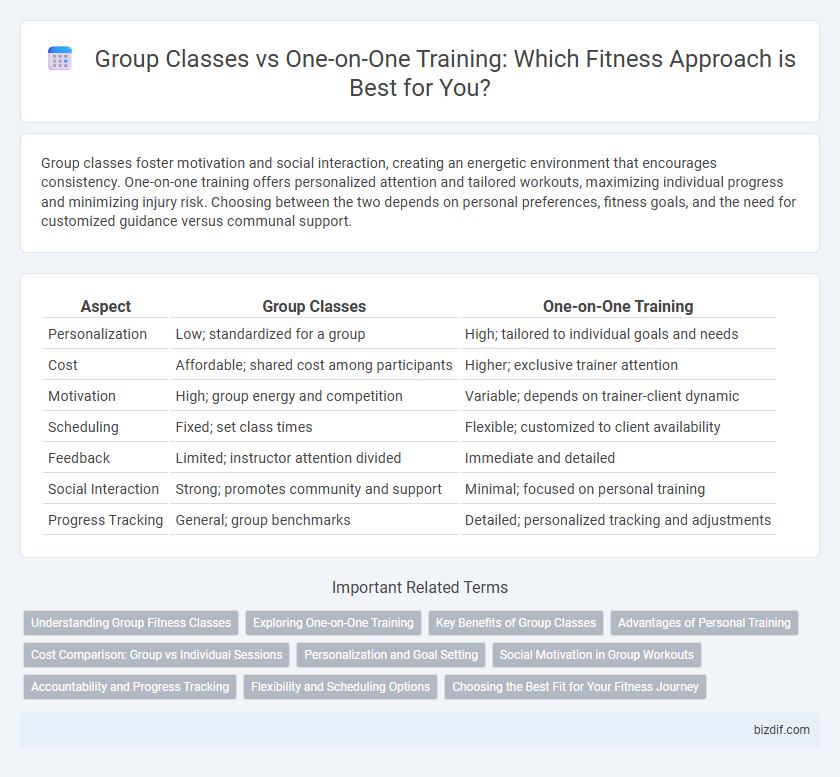Group classes foster motivation and social interaction, creating an energetic environment that encourages consistency. One-on-one training offers personalized attention and tailored workouts, maximizing individual progress and minimizing injury risk. Choosing between the two depends on personal preferences, fitness goals, and the need for customized guidance versus communal support.
Table of Comparison
| Aspect | Group Classes | One-on-One Training |
|---|---|---|
| Personalization | Low; standardized for a group | High; tailored to individual goals and needs |
| Cost | Affordable; shared cost among participants | Higher; exclusive trainer attention |
| Motivation | High; group energy and competition | Variable; depends on trainer-client dynamic |
| Scheduling | Fixed; set class times | Flexible; customized to client availability |
| Feedback | Limited; instructor attention divided | Immediate and detailed |
| Social Interaction | Strong; promotes community and support | Minimal; focused on personal training |
| Progress Tracking | General; group benchmarks | Detailed; personalized tracking and adjustments |
Understanding Group Fitness Classes
Group fitness classes offer a dynamic environment where participants benefit from social interaction, motivation, and a structured workout led by a certified instructor. These classes typically include a variety of formats such as HIIT, yoga, and spin, providing diverse options that cater to different fitness levels and goals. The collective energy and group accountability often enhance consistency and enjoyment, making group classes an effective choice for those seeking community-driven fitness experiences.
Exploring One-on-One Training
One-on-one training offers personalized fitness plans tailored to an individual's goals, abilities, and progress, ensuring maximum efficiency and injury prevention. The direct interaction with a trainer allows for constant feedback and motivation, fostering faster improvements and better technique mastery. Customized attention in one-on-one sessions creates a highly adaptive workout environment compared to the generalized approach in group classes.
Key Benefits of Group Classes
Group fitness classes offer a motivating atmosphere that enhances social interaction and accountability, leading to consistent workout commitment. These classes often provide structured routines guided by expert trainers, ensuring proper form and diverse exercises suitable for all fitness levels. Cost-effective compared to one-on-one training, group sessions deliver high-quality instruction while fostering a supportive community environment.
Advantages of Personal Training
Personal training offers tailored workout plans designed to meet individual fitness goals, ensuring efficient progress and injury prevention. Trainers provide real-time feedback and motivation, optimizing technique and enhancing workout effectiveness. Customized sessions accommodate specific needs such as rehabilitation or advanced athletic performance, delivering a personalized fitness experience unmatched by group classes.
Cost Comparison: Group vs Individual Sessions
Group fitness classes offer a more cost-effective solution, averaging $15-$30 per session, compared to one-on-one training, which can range from $50 to $100 per hour depending on the trainer's expertise and location. The shared environment in group sessions reduces individual costs while maintaining access to professional guidance and motivation. Individual training delivers personalized programs and focused attention, justifying the higher investment for targeted fitness goals and injury prevention.
Personalization and Goal Setting
Group classes offer a motivating environment with structured workouts designed for general fitness goals, while one-on-one training provides personalized programs tailored to individual needs and precise goal setting. Personalization in one-on-one sessions enables trainers to adjust exercises based on progress, limitations, and specific objectives such as weight loss, muscle gain, or rehabilitation. This targeted approach often leads to more efficient results and higher accountability compared to group settings.
Social Motivation in Group Workouts
Group fitness classes foster social motivation by creating a sense of community and accountability, encouraging participants to push harder alongside peers. This collective energy enhances adherence and enjoyment, making workouts feel less like a chore and more like a social event. In contrast, one-on-one training offers personalized guidance but lacks the dynamic social interaction that elevates motivation in group settings.
Accountability and Progress Tracking
Group classes foster accountability through shared goals and peer motivation, enhancing consistency in workouts. One-on-one training offers personalized progress tracking, enabling tailored adjustments for optimal performance improvements. Combining both formats can maximize accountability and precise monitoring of fitness milestones.
Flexibility and Scheduling Options
Group fitness classes offer a variety of flexible scheduling options, often available multiple times per day to accommodate diverse lifestyles. One-on-one training provides personalized flexibility, allowing sessions to be scheduled precisely around individual availability and specific fitness goals. Both formats enhance accessibility, but one-on-one training maximizes customized scheduling and adaptability to personal time constraints.
Choosing the Best Fit for Your Fitness Journey
Group classes offer an energetic atmosphere and social motivation, ideal for those who thrive on community support and varied workouts. One-on-one training provides personalized guidance and tailored programs, perfect for individuals with specific fitness goals or needing specialized attention. Assessing your motivation style, fitness objectives, and schedule flexibility helps determine whether group sessions or personal training best aligns with your fitness journey.
Group classes vs One-on-one training Infographic

 bizdif.com
bizdif.com